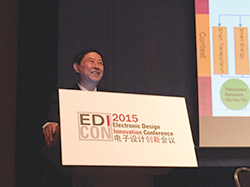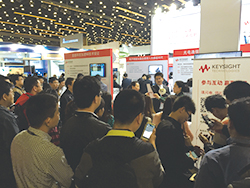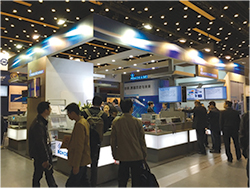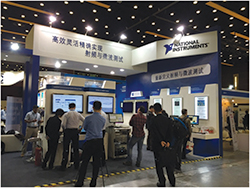
Figure 1 Professor Song from Beijing University of Posts and Telecommunications opened the plenary with a keynote presentation about smart cities.
EDI CON China 2015 took place in the heart of the Beijing Olympic Village on April 14−16 at the China National Convention Center (CNCC). Over the three-day event, a record setting 2625 attendees visited the exhibition and conference with a delegate count of 1214. The conference featured five parallel tracks on topics such as amplifier and component design, radar simulation and analysis, design for the Internet of Things (IoT), RF/microwave measurement and modeling, high speed design and measurement, subsystem and system design, PCB and connector design, and EMC/EMI modeling and measurement. New this year was a full day 5G forum featuring keynotes by China Mobile and Ericsson, an expert panel session, eight technical sessions and two workshops. The 5G panel keynote session had 124 attendees, the panel session more than 150. The average session size for all of the EDI CON sessions and workshops was close to 50 attendees.
The plenary kicked off with EDI CON Chairman Professor Song from the Beijing University of Posts and Telecommunications discussing Smart Cities (see Figure 1). He stated that more than 500 smart cities are under development in China with a forecast of $5 trillion in investment through 2017. Keynotes from China Mobile, China Unicom and ZTE followed, discussing their visions of 5G and the latest results for 5G prototypes. China Mobile highlighted their smart tile transceiver approach to massive MIMO for 5G deployments. The three main sponsors – Keysight Technologies, Rohde & Schwarz and National Instruments – also presented on the latest trends in test and measurement and their contributions to 5G research. This was followed by the Keysight sponsored reception dinner, where about 350 attendees enjoyed traditional Chinese cuisine and music.
The exhibition had close to 100 companies displaying products and services. The wide range of products included test and measurement, software/modeling, devices/components, EMC/EMI, PCB materials and cable/connector companies. Our three main sponsors’ displayed the following products at the exhibition.

Figure 2 Delegates watch one of many demos at the Keysight booth.
Keysight, the host sponsor of EDI CON, had many demos in their booth showcasing their cutting edge test and measurement systems (see Figure 2). They had a 5G demo to verify wide bandwidth Tx/Rx prototypes in real environments, helping to implement new 5G candidate waveforms that generate up to 4 GHz of bandwidth for both sub-6 GHz and mmWave frequencies and reach up to 10 Gbps data throughput.
For high speed digital applications, Keysight offers complete PAM-4 solutions for simulation plus input and output design characterization for 32 Gbaud and beyond. The company provided an overview of PAM-4 and PAM-N designs, an explanation of the latest measurement techniques, and an illustration of design and debug approaches and test solutions. Keysight’s solutions for DDR memory applications are driven and supported by Keysight experts that are active in the Joint Electronic Devices Engineering Council (JEDEC). Their involvement in standards groups enables Keysight to bring the right solutions to the market when customers need them. Keysight offers a complete solution set from electrical to protocol. The Keysight E5080A is the next-generation ENA Series Network Analyzer, providing best-in-class performance, flexible functionality and advanced usability. With its intuitive, touch-based interface, the E5080A streamlines measurement flow and achieves better results in less time. This new instrument implements a converged platform that leverages the best attributes of the ENA and PNA families.
Keysight’s one-box test solutions deliver fast measurement speeds, repeatable accuracy and flexibility for testing today’s mobile devices and femtocells. That translates to lower costs and increased profit margins for companies. Keysight offers solutions for testing all the major wireless technologies and wireless connectivity formats including: LTE-Advanced, LTE FDD, LTE TDD, GSM/GPRS/EGPRS/E-EDGE, W-CDMA/HSPA/HSPA+/DC-HSDPA, cdma2000®/1×EV-DO/eHRPD, TD-SCDMA/TD-HSDPA/TD-HSUPA, IS-95, TIA/EIA-136, AMPS, Bluetooth®, Bluetooth Enhanced Data Rate (EDR), Bluetooth Low Energy, ZigBee, 802.11 a/b/g/n/ac WLAN and WiMAXTM.

Figure 3 Rohde & Schwarz demonstrated 5G channel modeling using their vector signal generator system.
Rohde & Schwarz showed their vector signal generator system with optional integrated real-time MIMO fading that supports two RF ports (up to 20 GHz each) and two digital/analog I/Q outputs (to connect additional R&S®SGS100A/SGT100A RF units). They demonstrated this setup for 5G channel modeling at EDI CON China (see Figure 3). The I/Q modulator has up to 2 GHz RF modulation bandwidth (bandwidth of up to 160 MHz with internal baseband), with a phase coherence option, e.g., for beam forming applications. They also offer signal and spectrum analyzer and multi-port to support 5G development. The analyzer’s frequency range extends from 2 Hz to 8, 13.6, 26.5, 43.5, 50 or 67 GHz (with external harmonic mixers from Rohde & Schwarz extending coverage to 110 GHz) and with up to 500 MHz analysis bandwidth. The vector network analyzer product family offers a wide range of test capabilities, ranging from 9 kHz to 4.5, 8, 20 or 40 GHz and supports massive MIMO test applications using network analyzers with up to 24 test ports or switch matrix solutions up to 48 ports.
Rohde & Schwarz demonstrated an automotive sensor analysis and test system with a touch screen and Ethernet control operating at 77 GHz. It can simulate and measure the signal characteristics for a full sensor test suite. Another demo featured a multi-test system that can measure wide band communications, audio quality and environmental testing in one setup. Full performance and functional testing can be performed to international standards, with user equipment testing of data and audio quality from the user’s perspective.
Rohde & Schwarz has a wide range of oscilloscopes, from value class for service, maintenance and education to top instruments for R&D or EMI debugging in the 600 MHz to 4 GHz range. Their oscilloscopes provide high definition, real-time analysis. The integrated digital down-conversion provides fast feedback from EMI probing. Illustrating Rohde & Schwarz collaboration, they featured a load-pull demonstration with Focus Microwaves.

Figure 4 National Instruments featured their new signal analyzer that operates to 26.5 GHz with 765 MHz bandwidth.
National Instruments featured their new signal analyzer, which operates up to 26.5 GHz with 765 MHz of bandwidth (see Figure 4). Coupled with an FPGA module, many different types of signal analysis can be performed. Their demo included real-time spectral analysis with a POI of 1.5 microseconds. NI also demonstrated their 5G rapid prototyping system with a massive MIMO setup (16 antennas in the booth). The demo utilized USRP Rio radios and a PXI chassis to aggregate all of the data. This demo was a replica of the system being evaluated at Lund University.
A second 5G demo included the Rio radio evaluating alternative modulation schemes. It uses LABVIEW Communication Design Suite with reference designs (LTE, 802.11xx) that allows users to evaluate new waveforms, such as FBMC, UFMC, BFDM and GFDM. The design suite can load the reference design and allows researchers to modify portions of the standard signals to test different scenarios.
Join us next year for EDI CON China 2016 at the CNCC in Beijing, April 19−21, 2016
